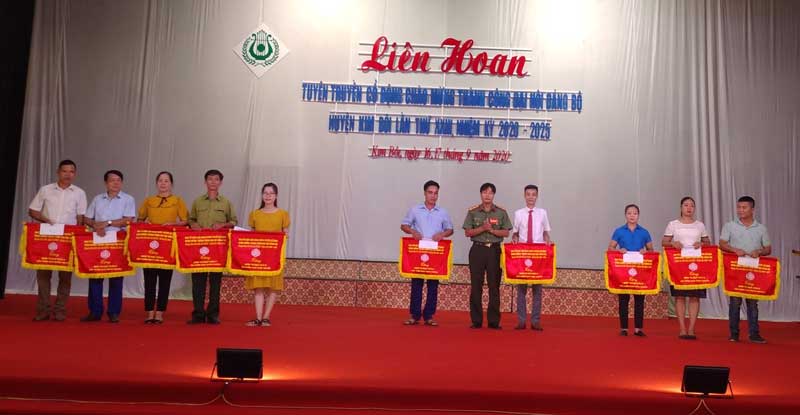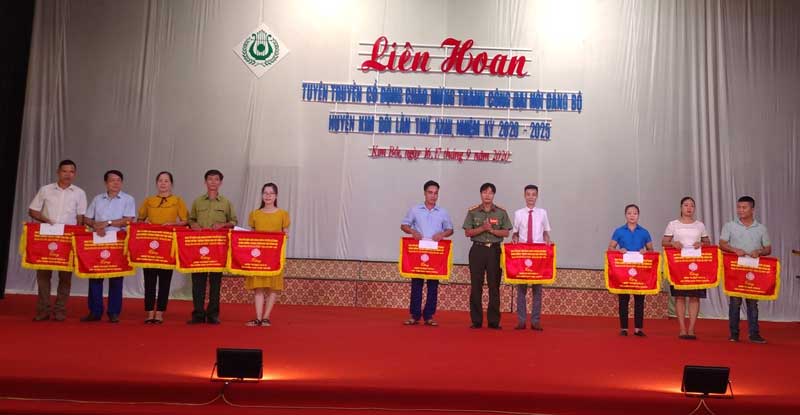
(HBO) - Kim Boi district has organized a propaganda festival to welcome the success of the XXIII District Party Congress, term 2020 - 2025.
 The organizing committee is awarding
prizes to the winning teams.
The organizing committee is awarding
prizes to the winning teams.
There
were 302 communicators and amateur actors from 16 units across the district
attending this festival. At the festival, each unit took part in the following
competitions: The photo presentation, the propaganda arts lasting no more than
35 minutes. The propaganda topics were the Party's guidelines and lines, the
State's policies and laws; the propaganda on the success of Party Congress at
all levels, towards the XIII Congress of the Party; the movement to build a new
countryside; the movement of learning and following Ho Chi Minh's ideology,
morality, and style.
With
the spirit of the serious practice and preparation, the careful investment in
the content, the costumes, the props and so on, the teams have confidently
shown their competition. Many teams had excellent exams, the message content
communicated was closely and easily to understand with the vivid and creative
way of presenting the content, leaving a lot of impressions for viewers.
The
festival purpose was to evaluate the quality of the cultural and artistic
movement in the localities, creating the conditions for communicators to learn,
exchange and share experiences and propaganda methods. At the same time, it
helped discover and foster the propaganda talents to participate in Hoa Binh
Provincial Festival of Propaganda and Encouragement held in the coming time.
The
results were as followed: the organizers awarded eight A prizes, twelve B
prizes, twenty-seven C prizes. The first prize of the whole group was awarded
to Bo town, the second prizes were awarded to Hung Son and Xuan Thuy communes,
the third prizes were awarded to Vinh Tien, Vinh Dong and Dong Bac communes.
The encouragement prizes were to Sao Bay, Kim Lap, Cuoi Ha, Tu Son communes.
With an increasingly vibrant and widespread emulation movement aimed at building cultured residential areas and cultured families, Yen Thuy District has been making steady progress toward improving both the material and spiritual well-being of its people, while fostering a civilized, prosperous, beautiful, and progressive community.
Once lacking recreational spaces and community facilities, Residential Group 2 in Quynh Lam Ward (Hoa Binh City) has recently received attention for the construction of a new, spacious, and fully equipped cultural house. The project followed the model of state support combined with public contributions in both labor and funding.
The "All people unite to build cultural life" movement, which has been effectively integrated with Kim Boi district’s socio-economic development goals, is fostering a lively spirit of emulation across local residential areas, hamlets, villages, public agencies, and enterprises. In addition, through the initiative, traditional cultural values are being preserved and promoted, while community solidarity and mutual support in poverty reduction and economic development are being strengthened.
A working delegation of the Hoa Binh provincial People’s Committee led by its Permanent Vice Chairman Nguyen Van Toan on June 11 inspected the progress of a project to build the Mo Muong Cultural Heritage Conservation Space linked to tourism services in Hop Phong commune, Cao Phong district.
Born and growing in the heroic land of Muong Dong, Dinh Thi Kieu Dung, a resident in Bo town of Kim Boi district, in her childhood was nurtured by the sweet lullabies of her grandmother and mother. These melodies deeply imprinted on her soul, becoming an inseparable part of her love for her ethnic group's culture. For over 20 years, this love for her hometown has driven Dung to research, collect, and pass down the cultural values of the Muong people to future generations.
In the final days of May, the Ethnic Art Troupe of Hoa Binh Province organized performances to serve the people in remote, mountainous, and particularly disadvantaged areas within the province. These were not just ordinary artistic shows, but they were the meaningful journeys aimed at spreading cultural values, enhancing the spiritual life of the people and contributing to the preservation of ethnic minority cultural identities.



 The organizing committee is awarding
prizes to the winning teams.
The organizing committee is awarding
prizes to the winning teams.